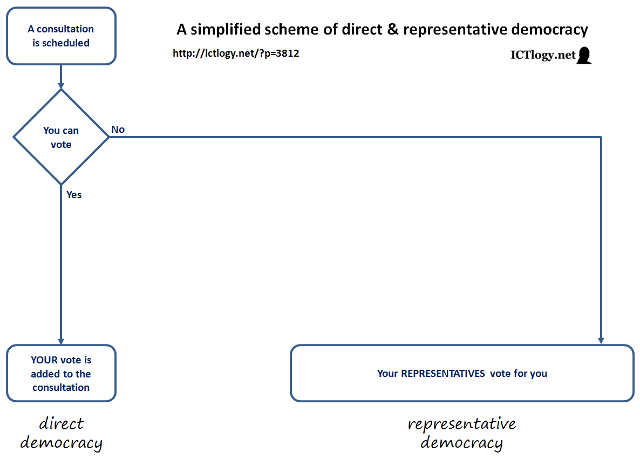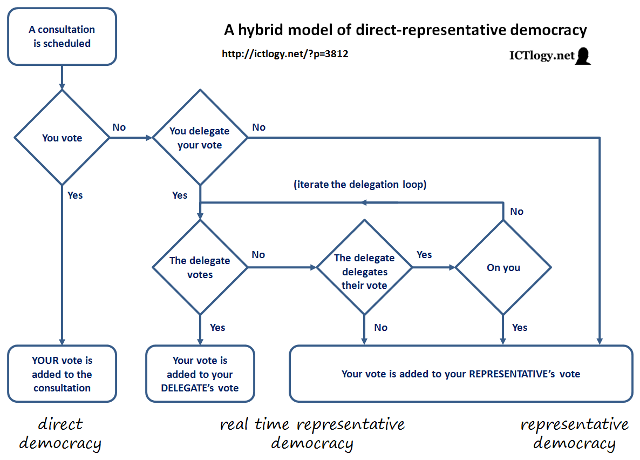In a democracy, we are traditionally faced with two different options: we either can vote a policy or a decision (direct democracy), or we cannot vote and then our representatives (usually selected after an electoral process) vote for us (representative democracy). Indeed, the latter is the most usual, while increasingly more people would rather the former.
Some of the criticisms to representative democracy — and that are usually used to legitimate and claim for more direct democracy — are that:
- We sometimes know better than our representatives what it is good for us.
- We are almost always forced to vote a “pack” of ideas/policies, of which we only partly agree with. Thus, we are not fully represented by our representatives.
- Representative democracy was efficient in an analogue world. In a digital world, that efficiency is, to say the least, questioned, as digital voting comes marginally at zero cost.
Some of the criticisms to direct democracy — and that are usually used to dis-encourage and stop any claim for more direct democracy — are that:
- We sometimes do not master the topic that is voted. Thus, we would incur in insurmountable personal costs if wanting to cast an informed vote for each and every collective decision.
- There are people that do not care, have no time or have no means to be actively involved in politics/voting. Direct democracy then fosters plutocracy.
So, it would be great to be able to have a way to keep the best of both worlds: when we can vote, we’d do it; when we don’t, we’d delegate our vote on our representatives… or on the ones we trust for a specific subject.
Let us imagine a system where direct and representative democracies can live together. Actually, this is what most democracies do have right now. But let us imagine that each and every decision can be taken both ways simultaneously: if no citizen votes, the process takes the form of pure representative democracy; if each and every citizen votes, the process takes the form of pure direct democracy; is some citizens vote, the elected representatives vote only on behalf of the citizens that did not vote, and the final result is calculated by taking into account the individual citizens’ votes and the votes of the representatives, these weighting us much as the aggregate of votes of the ones they represent and that did not vote.
Technologically speaking, the preceding system is a “simple” one to implement: all citizens decide, first place, what is their preferred party and inform the system with their preferences. Once a consultation is scheduled, citizens log in and vote. If they do not vote, the vote goes to the representative that was initially informed in the system. Blank voting is one of the given options and abstention happens when the voter neither votes nor informs a representative in the initial setup of the system. If needed or desired, territorial weighting, district distribution, etc. can be informed and applied during the final counting of votes.
An intermediate layer can be added to this system: the expert on whom we delegate our vote. A citizen may not want their representative to vote for them: e.g. imagine a right wing, pro-environment and atheist citizen deciding whether their preferred liberal party (known for its bounds with the energy industry) should represent them in a referendum on nuclear power. The citizen has concerns or irresolvable doubts on nuclear power and would like their “green engineer” friend to vote for them (but right now cannot ask for direct advice). Same for a referendum on abortion: that citizen cannot decide, but knows the liberal party will vote against based on religious beliefs that they do not share: they’d rather ask their physicist friend working on genomics.
With a hybrid system, the citizen has now three options: voting directly; not voting and letting the elected representative to vote for them; delegating their vote on an expert or a trusted friend or the leader of the local community.
The workings of the system would be as follows:
Note that there are, actually, five options, three of them ending up in the representative democracy as usual. Bear in mind that voting “blank” should be an option of the system. As many others have pointed before, electronic voting systems don’t usually allow for “null” votes (some even include the option in the system, a solution that I do not really fancy):
- The citizen votes directly and their vote is counted up individually against all other votes (weighted by district if necessary).
- The citizen delegates their vote, and the delegate (friend, expert, etc.) decides to vote directly. In that case, the delegate is voting per two people (or as much as people delegate on them).
- The citizen neither votes nor delegates, and their is aggregated to the votes of the elected representative.
- The citizen delegates the vote, but the delegate is not voting, so the citizen’s vote “comes back” to them and, by default, to the elected representative.
- The citizen delegates their vote, but the delegate just happened to delegate their vote back to the initial voter: the loop is solved by sending both votes “up” to their respective elected representatives.
There is the possibility that a citizen delegates their vote, and the delegate does it too on a third person. In that case, it is just a matter of iterating the system until it gets to a case between the ones listed above.
There are two questions left open and that have to be solved arbitrarily, though solved before the system begins to work, as the results of the system we have just described can vary depending on how those questions are addressed.
The first one is whether a citizen can change in the system their (a) elected representatives and (b) the people on whom they delegate.
Our opinion is that representatives can only be chosen once every political cycle begins (e.g. once every four years and just after the elections — indeed, setting up the system defaults would be the elections), but delegates should be free to choose for each and every consultation scheduled.
The second one is whether (a) elected representatives know how many votes they have and (b) delegates know it too.
In our opinion, elected representatives should be able to know how many people chose them as default. That would gave them an idea of the potential support they more or less have at any given time, though they have to keep in mind that while citizens can vote directly vote or delegate, data from the initial election of representatives is just an approximation. Indeed, there would be huge incentives in being faithful to the original programme and electoral promises to avoid people to “vote for themselves” and trust their vote to them instead.
On the other hand, there are two reasons for which delegates knowing how many voting power they have got is a not very much convincing idea: the first one is a technical one, as the citizen should either be able to vote at the last minute or change their vote many times before the poll closes. The second one is that it would probably be an open gate to corruption and unfair lobbying, vote selling and other similar practices.
I would be very interested in contributing to an actual implementation of this system, maybe within a social networking site, maybe as an open government website being fed by parliamentary data with which compare with the experiment’s citizen decisions. If you have the possibility to make it happen, please drop me a line.
If you need to cite this article in a formal way (i.e. for bibliographical purposes) I dare suggest:
Peña-López, I. (2011) “A hybrid model of direct-representative democracy” In ICTlogy,
#95, August 2011. Barcelona: ICTlogy.
Retrieved month dd, yyyy from
https://ictlogy.net/review/?p=3812
Previous post: Volunteering from home, the office or the train: online volunteering, social networking sites and smartphones
Next post: Mobile communication and economic and social development in Latin America
10 Comments to “A hybrid model of direct-representative democracy” »
 RSS feed for comments on this post.
TrackBack URI
RSS feed for comments on this post.
TrackBack URI




In my country a political party has made true the dream of living together direct democracy and representative democracy.
They designed an online part of their web site (called “space democracy “). From this space their supporters can decide the meaning of the parliamentary group vote on those issues that were not part of the electoral program that was presented to the elections (http://goo.gl/JDco8).
To be able to master the topic that has to be voted, their supporters have acces to the specific laws and proposals, and the opinion of the political party. In addition they can share comments with their opinions. Against plutocracy, it is essential that the knowledge flows, and perhaps this is still weak.
Maybe it’s not perfect but is the best offered by the current political landscape.
On the other hand, and from my point of view, a regenerated hybrid democratic system should give more weight to “my representative” (who I voted and who can be claimed for outcomes), and less value to the delegates (often as a fee of the political parties for the head of the list to reach the power).
Pingback: Apunte sobre la democracia directa -- La maldekstra kolono
Jaume,
Though “space democracy” looks nice, it looks to me like an improvement (and a good one, indeed) of representative democracy, but not of direct democracy, which is voting directly without intermediaries.
Concerning representatives and delegates, I agree on the part of representatives, and I believe it is gathered in the model I just depicted. But I am not talking about our “usual” delegates, but about me delegating on you, as a citizen, my vote for some specific topics: no parties, no elected representatives, just citizens trusting one each other :)
Pingback: Democracia 4.0 y una aportación para el programa de ICV-EUiA -- La maldekstra kolono
Pingback: ¿Cómo comunicar el trabajo de los diputados? Tuitdebate « quehacenlosdiputados
Pingback: ¿Cómo comunicar el trabajo de los diputados? Tuitdebate | Qué hacen los diputados
Pingback: Desintermediación en democracia ¿en qué sentido?
Pingback: ICTlogy » SociedadRed » Desintermediación en democracia ¿en qué sentido?
Pingback: Desintermediación en democracia, ¿en qué sentido? - Hordago
Pingback: ICTlogy » ICT4D Blog » Current challenges of online participation: a citizen e-participation journey